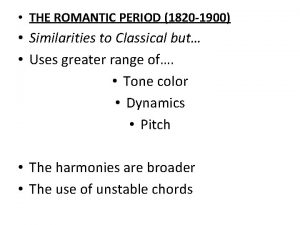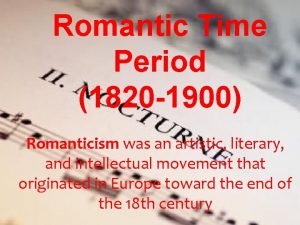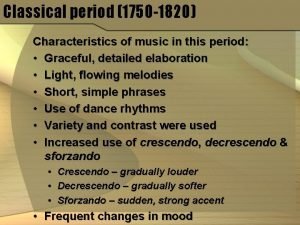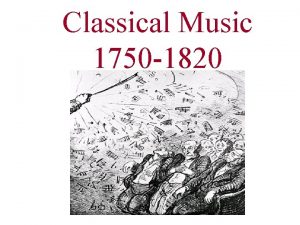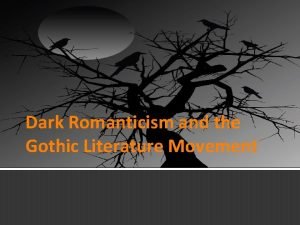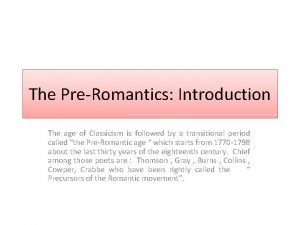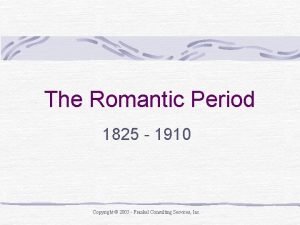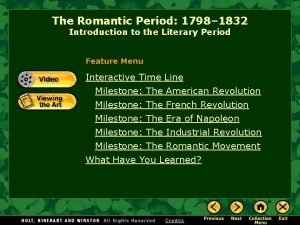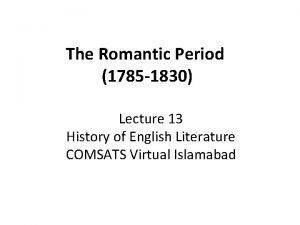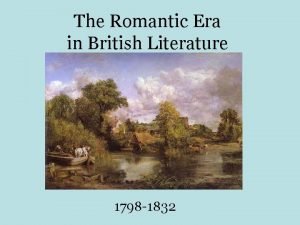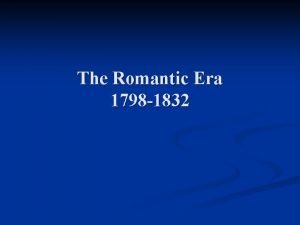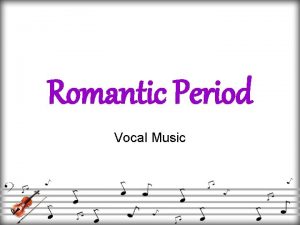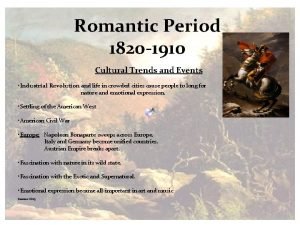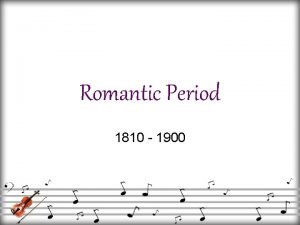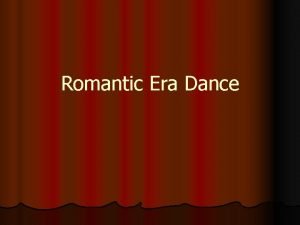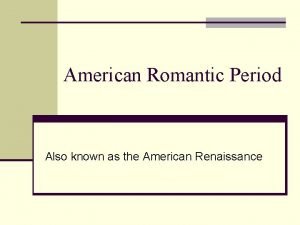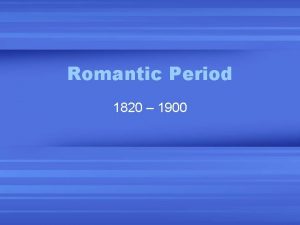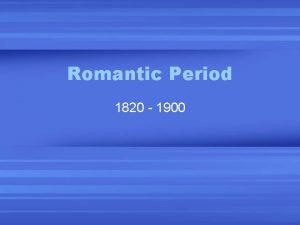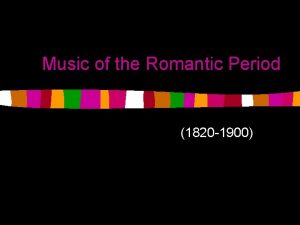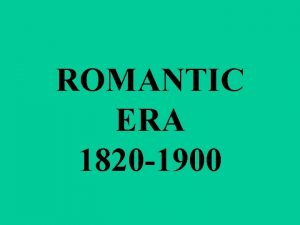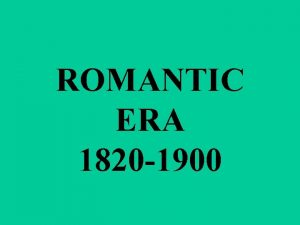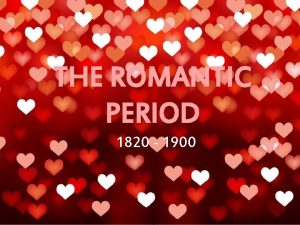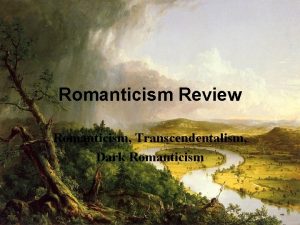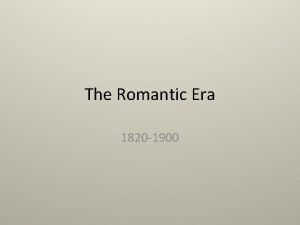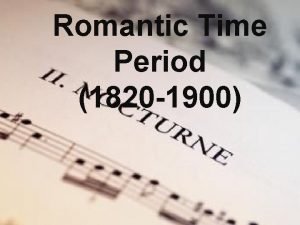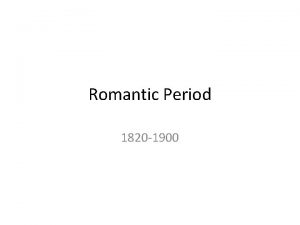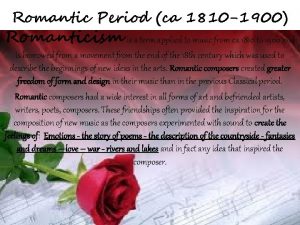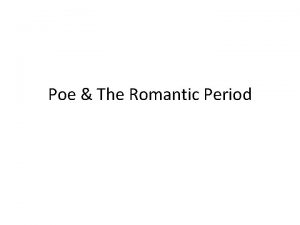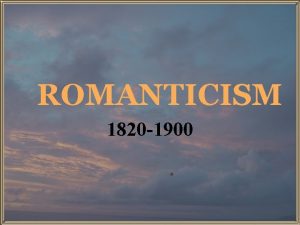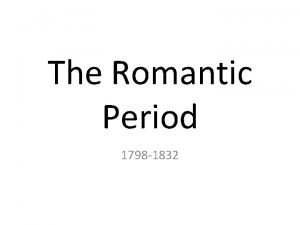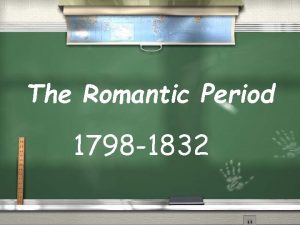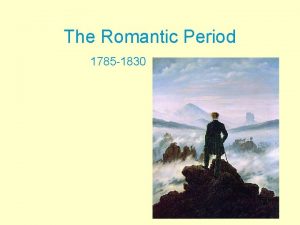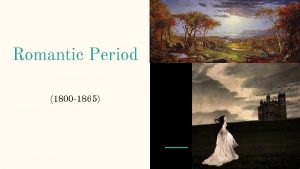Romantic Time Period 1820 1900 Romanticism was an

























- Slides: 25

Romantic Time Period (1820 -1900) Romanticism was an artistic, literary, and intellectual movement that originated in Europe toward the end of the 18 th century

Romantic Time Period (1820 -1910) • Confusion in dates? • There is a transition time between time periods. You can see characteristics from both time periods • The Romantic era grew out of the social and political upheavals that followed the French Revolution • This new society placed a lot of emphasis on the individual (individualism)

What was Romanticism? The movement placed strong emphasis on emotions such as apprehension and terror It elevated folk art and ancient customs It made spontaneity a desirable characteristic Romanticism reached beyond the Classicist ideas It attempted to embrace the exotic and unfamiliar It harnessed the power of the imagination

• Slogan: “Liberty, Equality, Fraternity” • What do each of these words mean? Liberty? • Equality? • Fraternity? •

• Slogan: “Liberty, Equality, Fraternity” • What do each of these words mean? Liberty-right to choose, Freedom • Equality – State of being equal; equal to all others in a specific group • Fraternity – brotherly love; feelings of friendship and mutual support between people •

Romanticism in Music The Arts mirror the profound changes that were taking place during this time period

Improvements to Instruments • The industrial revolution brought about means to create better instruments. 1. The cost to make the instruments was cheaper 2. More responsive instruments 3. Technical improvements • The addition of valves to brass instrumentsmade playing the instruments much easier 4. New instruments created • • Tuba Saxophone

Piano • Golden age of the piano • Most households had a piano • Originally called the pianoforte because it had the ability to play both loud (forte) and soft (piano). Later shorted to just piano. • Piano had a cast-iron frame • Thicker strings gave it a deeper and more brilliant tone • Easier to tune. More tension on the strings. • Steinway piano company was very popular. Still is today.

Broadening Educational Opportunities • New conservatories were established • Conservatory-an institution or school where students are taught one of the arts, most commonly music or drama, to a professional standard • As a result of more conservatories, composers could count on having performers with greater capabilities and higher skill levels. • Could write more difficult music.

Orchestras • Increased in size. • This gave composers a more varied and colorful means of expression • New instruments (different timbres) • • • Piccolo English horn Contrabassoon • These instruments expanded the range of the orchestra. They could play extremely high and also extremely low notes • Dynamic range increased • Added drama

Musical Language Helped composers communicate their exact intentions of how the music should be played Dolce – sweetly Cantabile – songful Dolente – weeping Mesto – Sad Maestoso – Majestic Con Amore – with love, tenderly

Romantic Music Traits 1. Tried to make the instruments “sing” Lyrical Melodies 2. Emotional and Expressive 3. Expanded instrumental forms A symphony by Haydn or Mozart takes about 20 minutes to perform. One by a Romantic composer may take twice as long 4. There was meaning behind the music Meditations of life and death Human destiny God and nature Pride in one’s country Political struggles Ultimate triumph over good and evil

Franz Schubert Born in a suburb of Vienna Son of a schoolmaster Learned to play the violin from his father and the piano from an older brother Beautiful singing voice Was a Vienna Choir boy His teacher were astonished at his musical abilities, especially since he was very shy He tried to follow in his father’s footsteps and become a teacher, but teaching was not for him He found his escape through music One of his friends commented “Everything he touched turned to song. ”

Franz Schubert He had a very difficult life. Suffered from syphilis and was usually pressed for money. He sold a lot of his music for less than what it was worth. He died when he was only 31. His dying wish was to be buried near the master he worshipped above all others –Beethoven. His wish was granted. He wrote over 600 songs He could write these songs very quickly. Sometimes he would write 5, 6 or 7 in a single morning.

Erlking Franz Schubert’s most famous song was “Erlking” This song gave him immediate public recognition This song is based on the legend of the “Elf King” If the Elf King touches a human, they will die. The Elf King seeks vengeance on humans to get revenge for his daughter. The eerie atmosphere of the poem is immediately established by the piano. The poem has 4 characters: the narrator, the father, the child, and the Elf King It is all sung with the same voice. He changes his voice for each character. The boy is terrified and the father is trying to calm him, and the Elf King is scary and dark.

Erlking Who rides, so late, through night and wind? It is the father with his child. He has the boy well in his arm He holds him safely, he keeps him warm. "Do you want to come with me, pretty boy? My daughters shall wait on you finely; My daughters will lead the nightly dance, And rock and dance and sing you to sleep. " "My son, why do you hide your face so anxiously? " "Father, do you not see the Elfking? The Elfking with crown and tail? " "My son, it's a wisp of fog. " "My father, my father, and don't you see there The Elfking's daughters in the gloomy place? " "My son, my son, I see it clearly: There shimmer the old willows so grey. " "You dear child, come, go with me! Very lovely games I'll play with you; Some colourful flowers are on the beach, My mother has some golden robes. " "My father, my father, and don't you hear What the Elfking quietly promises me? " "Be calm, stay calm, my child; The wind is rustling through withered leaves. " "I love you, your beautiful form entices me; And if you're not willing, then I will use force. " "My father, my father, he's grabbing me now! The Elfking has done me harm!" It horrifies the father; he swiftly rides on, He holds the moaning child in his arms, Reaches the farm with trouble and hardship; In his arms, the child was dead

Robert Schumann Born in Germany His mother insisted that he attend law school. While he was in law school he decided he had a passion for music, and his ambition was to become a pianist. He had a very late start with piano lessons and practiced intensively to make up for the missed time. He never became the great pianist he had hoped to become. Possibly because of his late start, but he also had some physical handicap with his right hand. Instead of becoming a pianist, he turned to composition.

Robert Schumann Married Clara who was a pianist The 2 musicians worked side by side. Clara was part of the reason he became so popular. Robert would write the music and Clara would play it on the piano. Robert was very ill suited for public life. He had a lot of problems such as hallucinations In a fit a depression, he attempted suicide by throwing himself into the Rhine River. He died at the age of 46.

Frederic Chopin Nickname “Poet of the Piano” National composer of Poland Fell in love with a novelist named George Sand He was most productive while married to her Eventually their relationship ran its course and they parted ways He died of tuberculosis at the age of 39. They played his very own “Funeral March” at his funeral. Best known work : Nocturne in C minor

Musical Nationalism – Patriotism, proud loyalty or devotion to a nation Nationalism in music was expressed in many ways 1. 2. 3. 4. Songs and dance of their culture Folklore or peasant life Celebration of national heroes, historic events Scenic beauty of their country Nationalistic music was so important to the people that often times if a country had been capture or was run by another nation, they were forbidden to play their nationalistic music. Nazi’s in WWII forbade the people of Warsaw to play Chopin’s music because of the powerful symbolism behind the words.

Bedrich Smetana (1824 -1884) Nationalistic composer from Bohemia (Czech Republic) Lived while Bohemia was struggling under Austrian rule Wrote “Ma Vlast” (My Country) This work was inspired by the beauty of Bohemia’s countryside Second Movement “The Moldau” – one of Bohemia’s rivers Rippling streams that flow through the forest to the mighty river Hunting scene with French horns Peasant wedding Fairy-tale setting Finally approaches the capital city of Prague, it flows past the castles and fortresses Goes out to the sea and fades away

Richard Wagner Most important figure in the German opera He was mostly self-taught. He only received about 6 months of instruction in music theory When he was 20 he abandoned his academic studies and obtained a position as chorus master in a small opera house. Wagner did away with the old opera. He wanted to create a “continuous fabric of melody that would never allow the emotions to cool. ”

Giuseppe Verdi Italian Romantic composer primarily known for his operas Guiseppe Verdi -- "Joe Green, " in Italian Born during a time of war in Italy (Napolean Bonaparte was gaining control of the area of Italy) Italian patriot. His music became part of the Italian fight for independence and unity.

Peter Tchaikovsky Russian Son of government official and also pursued a career in the government. He resigned at age 23. Entered the Conservatory at St. Petersburg He completed his music courses in 3 years and was immediately recommended for a teaching post in the new Moscow Conservatory. He was a very sensitive man. Suffered a lot from depression. Music was his outlet He considered himself a nationalistic composer. He said “I am Russian through and through!”

Peter Tchaikovsky Best known work is The Nutcracker Includes many dances, especially the waltz Many performers complained that the music was too complicated to dance to Dance of Sugar Plum Fairy Russian Dance Arabian Dance Full Ballet
 Characteristic of the romantic period
Characteristic of the romantic period What period lasted from 1750-1825?
What period lasted from 1750-1825? 1820-1900
1820-1900 Classical period characteristics
Classical period characteristics 1750 to 1820 classical music
1750 to 1820 classical music Romantic time period
Romantic time period Gothic romanticism literature
Gothic romanticism literature Pre romantic age poets
Pre romantic age poets The romanticism (1795 — 1835) what is romanticism
The romanticism (1795 — 1835) what is romanticism Wagner romantic
Wagner romantic Romantic period in american literature
Romantic period in american literature Characteristic of romantic period
Characteristic of romantic period The era of change 1798-1832
The era of change 1798-1832 The romantic period 1785 to 1832
The romantic period 1785 to 1832 Romantic period 1798 to 1832
Romantic period 1798 to 1832 Romantic period
Romantic period The romantic period 1798 to 1832 summary
The romantic period 1798 to 1832 summary Characteristics of romantic period
Characteristics of romantic period Vocal music of the romantic period
Vocal music of the romantic period Period
Period Romantic period poetry characteristics
Romantic period poetry characteristics Music of the romantic period
Music of the romantic period Characteristic of the romantic period
Characteristic of the romantic period Romantic era ballet
Romantic era ballet The youth became completely rebellious this period
The youth became completely rebellious this period American romantic period
American romantic period
